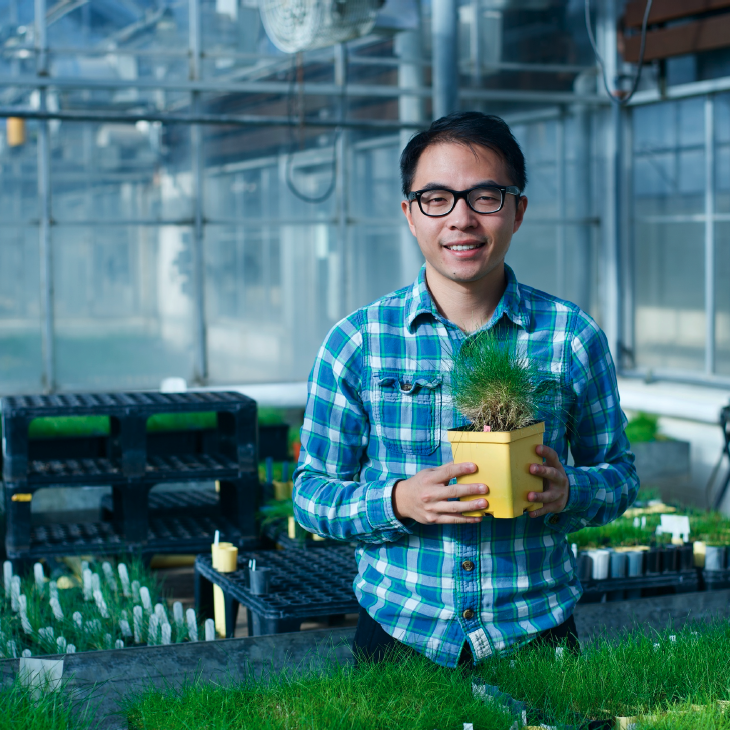By Yinjie Qiu
For this blog post, as the last blog post from me for a while, I would like to share my story with turfgrass starting August 2015.
I have always been interested in plant science since I was a kid. Time flies and 20 years later, I still enjoy plant science and have recently completed a Ph.D. in Applied Plant Sciences at the University of Minnesota. Prior to joining the turfgrass research group in 2015, I earned a M.S. degree in molecular biology, focusing on maize genetics. Because maize genetics is so well studied with lots of genetics resources available, a variety of breeding methods could be applied to maize breeding and genetics for cultivar development. Soon I would become fascinated by turfgrass genetics as well. For example, during my interview for the Ph.D. student position at the U of M, Dr. Eric Watkins explained to me that some turfgrasses produce some secondary metabolites that have an herbicide effect, and that it would be interesting if we could find out what they are so we could use them as natural herbicides. Learning about this one aspect of the turfgrass led to my initial interest in turfgrass research and I accepted a Ph.D. student position in the Turfgrass Science lab.
At the beginning of my Ph.D. research, I was really interested in pink snow mold resistance in fine fescues and I wanted to develop fine fescue cultivars with better pink snow mold resistance. However, I realized there are a lot of pieces of information that were missing, which made it challenging for us to conduct a study to elucidate the mechanism of pink snow mold resistance. These challenges included, but were not limited to, lack of genomics resources (genome, transcriptome) and lack of diversity in the germplasm. I went on a literature hunt to see what else could help us develop good disease resistant cultivars besides using plant breeding and genetics methods. Through this, I learned fungal endophytes (fungus that forms a symbiotic relationship with the host grass) could alleviate some turfgrass stresses. However, the methods to study fungal endophyte effects were done through heavy use of fungicide, but how the fungicide affects plant physiology was yet to be studied. Taken together, my Ph.D. research focus was shifted more towards developing genomics resources of fine fescues taxa and studying how plants respond to the heavy use of fungicide.
Through my Ph.D. research, I developed a method for fine fescue identification using a combination of molecular markers and flow cytometry. I further worked with undergraduate researchers to screen germplasm of the USDA Festuca ovina (sheep fescue) collection; this work will benefit plant breeders in selecting and identifying fine fescue germplasm so it can be used in the breeding program. Additionally, I developed the first reference transcriptome of hard fescue (Festuca brevipila) using one of the most advanced sequencing technologies: PacBio Isoform Sequencing. With this high-quality reference transcriptome, I was able to use a phylotranscriptomic approach to study the genome composition of this taxon. This further advanced our knowledge of the hard fescue genome and will allow breeders to use more breeding techniques for germplasm improvement, such as creating new hard fescue by hybridizing different species.
Finally, returning to my original interests when I started in my Ph.D., I researched how hard fescue responds to the heavy use of propiconazole fungicide. This part of research was done using a combination of transcriptome sequencing and metabolomics approach. My results shed light on the molecular mechanism of why triazole fungicide has been used as a plant growth regulator. We also found the plants had a long-term memory after the heavy fungicide application: fungicide-sprayed plants showed increased pink snow mold resistance even six months after the initial application, which helped to identify genes that might regulate enhanced resistance to the pathogen. This information could benefit turfgrass breeders on improving pink snow mold resistance in turfgrass species.
Every story has to come to an end, even though there are so many aspects that one can explore in turfgrass breeding and genetics research. It has been a wonderful journey of four years and eight months working with amazing colleagues in turfgrass research group. I am inspired by everybody in this group for their passion and dedication for turfgrass research. I am beyond thankful for the adventure in turfgrass genetics. During these years, I saw as people from our team left for other positions. I will also start my next chapter as a postdoctoral research associate in Department of Agronomy and Plant Genetics at the U of M working on maize genomics. However, this is not a goodbye from me to turfgrass research. I hope I will learn more research methods on plant breeding and genetics, so I can bring new knowledge and breeding approaches back to turfgrass!
Research publications by Dr. Yinjie Qiu
- Yinjie Qiu, Ya Yang, Cory D. Hirsch, and Eric Watkins. 2020. Building a reference transcriptome for the hexaploid hard fescue turfgrass (Festuca brevipila) using a combination of PacBio IsoSeq and Illumina sequencing. bioRxiv, 2020.2002.2026.966952 (BMC Genomics, in review)
- Yinjie Qiu, Sierra Hamernick, Joan B. Ortiz, and Eric Watkins. 2020. DNA content and ploidy estimation of Festuca ovina accessions by flow cytometry. bioRxiv, 2020.2002.2006.938100 (Crop Science, in review)
- Garett C. Heineck, Yinjie Qiu, Nancy J. Ehlke, Eric Watkins. 2020. The fungal endophyte epichloë festucae var. lolii plays a limited role in mediating crown rust severity in perennial ryegrass. Crop Science. DOI: 10.2135/cropsci2019.06.0412
- Yinjie Qiu, Cory D. Hirsch, Ya Yang, and Eric Watkins. 2019. Towards improved molecular identification tools in fine fescue (Festuca L., Poaceae) turfgrasses: Nuclear genome size, ploidy, and chloroplast genome sequencing. Frontiers in Genetics. DOI: 10.3389/fgene.2019. 01223
Stay tuned for my future publications on Google Scholar.
